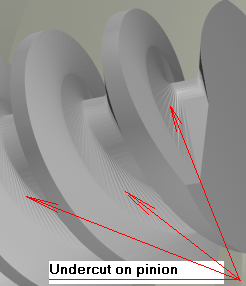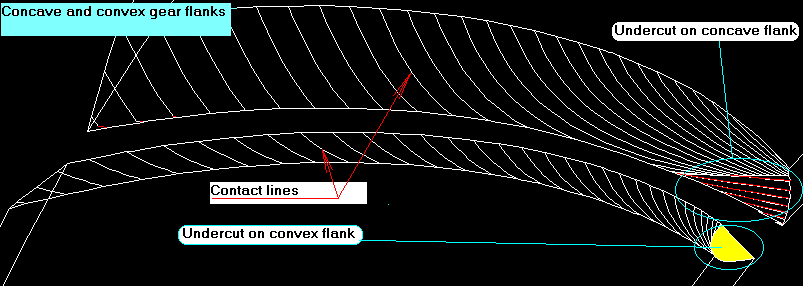Advanced digital alternative. Computer analyses, design and manufacturing.
DDS 3D-method is capable to describe mathematically any manufacturing processes including manufacturing of gear drives. This web site presents our investigation of skew axis face worm gears. Gear designs with tapered and cylindrical pinion were investigated.
Our modeling method allows simulate manufacturing of gears as well as the gear mesh. 3D visualization allows to examine geometry of the tooth surfaces as well as contact pattern and transmission error.
The tapered pinion shown below is a computer simulated by DDS. The tooth tip edge becomes a spire on the front view. This gives an idea about the source of the name given to the gears.
Here we would like to help better understand such of gears and give a guide line what to discuss in purchasing process. Below we revue typically proposed advantages of the gears:
1. Adjustable to zero backlash.
2. Transmit high power.
3. Variety of ratios.
4. Up to 400 ratio in one gear set.
5. Easy to mold.
6. Pressure angles on front and rear part of the pinion.
7. TCA and contact pattern developing.
Re. Adjustable to zero backlash..
Adjustment of the backlash is limited. DDS based computer program simulates the tooth contact pattern for all possible options of backlash adjustment. The backlash can be adjusted only on tapered pinion by moving the pinion along its axis. Only axial motion of the pinion does not change the contact pattern. Adjustment of the backlash on gears with cylindrical pinion is impossible without braking the contact. We can do free contact pattern calculation for you on our DDS computer models. Send your design data to
zak@zakgear.com for free evaluation.Re. Transmit high power.
It looks like the gear set can transmit higher power but it is not always true. Designers should not to expect much from the gears because the manufacturing process is often incorrect. Sales people say that the load is distributed between many teeth because high contact ratio. The contact ratio is really high but it is not always good for transmitting of high power. The load is not distributed evenly between the teeth so some teeth are overloaded. Unfortunately the accuracy of the gear manufacturing is not high enough the high tooth contact ratio. The manufacturing process does not allow to produce high accuracy gears. The pinion can be ground but it is impossible to use grinding for gear teeth finishing. The gear-cutting tool is just as small as the pinion. It deflects during cutting because its small diameter and it has very few cutting blades. Gear cutting ratio has to be the same as the gear set ratio so it is impossible to have a hunting ratio for cutting if the gear set does not have it. High contact ratio is good for transmission accuracy but it is not always good not for the gear strength. There is another big problem with the gear. Most of them have undercut of the gear and pinion tooth surfaces. Visually they look good but the real contact area has been decreased by the gear and pinion undercuts. Special software has to be used for calculation of undercut areas.


Re. Variety of ratios.
The ratios are limited because the pinion has 1,2 or 3 threads. The problem is the gear cutter. The gear cutter has to have the same geometry that the pinion so it has to have the same number of the threads. Unlike manufacturing of worm gears an oversized cutter can not be used. The cutter has a limit in its lead angle (some 25 degrees) so the pinion has the same limit. Hunting ratio is very desirable during the gear cutting for decreasing spacing error. In our case it is very important because the small and flexible cutting tool. The hunting ratio can be achieved only with 1 or 3 thread cutter. So good gear set ratio can be for example: 44:3 or 67:3 but not 66:3 or 72:3.
Re. Up to 400 ratio in one gear set.
The ratio is not limited by 400:1. It is incorrect to limit the ratio. Computer models with ratio 999:1 were created. However high ration brings more problems. High contact ratio and low accuracy gear face is not good for the load distribution in the mesh.
Re. Easy to mold.
The molding process is as easy as molding of hypod or spiral bevel gears. Unfortunately the gear manufactures can not provide the computer models of the gears. It does not allow to design a mold correctly. Plastic shrinks. It has to be taken in to account. Using oversized gear and pinion as electrodes does not solve the problem because it is impossible to cut the gear that is oversized in the same directions that plastic shrinks. 3D cad models have to be used for mold design and inspection. CAD model can be created from a master par by mapping on CMM. However such of model has low accuracy. DDS tool allows to create 3D CAD files of the theoretical gears.
Re. Pressure angles on front and rear part of the pinion.
The gears almost always have two different pressure angles on the same tooth. The front working angle is usually about 10 and rear angle is 30 degrees. Different pressure angles are not a very good solution for the drive that has to rotate in both directions. Computer models with equal pressure angles have been designed on DDS software.
Re. TCA and contact pattern developing.
DDS is a tool for Tooth Contact Analyses. It allows to simulate gear and pinion cutting process, show the contact pattern, calculate sliding, rolling and cutting velocities. DDS gear design method is not available at gear manufacturing companies in the US, UK or India. Digital investigation of different options for the contact pattern development results:
- It is impossible to achieve a localized contact pattern by using oversized gear cuter.
- The localized contact pattern can be achieved by the modified cutter or by modified pinion.
- The contact pattern is very sensitive for all of possible misalignment but not for axial of pinion.
DDS computer modeling method gear provides a manufacturing process that is different from the manufacturing process for spiral bevel or hypoid gears. The pinion can be ground on a thread-grinding machine and thread worm cutter generates the gear. The tooth profile on the pinion in section perpendicular to the axis is usually involute.
However other profiles can be used. In our experience a combination of concave - convex profiles increased efficiency and decreased gear mesh noise.
Manufacturing process for the pinion is usually grinding or turning. Gear can be cut on a regular gear hobber.
The design does not require having 90 degrees angle between gear and pinion axis. Gear sets with 75 and 105 degrees were manufactured and tested. They showed improved efficiency and smaller undercut areas. Double enveloping
wormoid pinion tooth form is an example of that.The surface of pinion tooth is a helical surface.
The gear tooth surface is more complicated for mathematical description. DDS method can be used for 3D gear tooth geometry calculation. There are some interesting facts about the gear tooth surface. There is a section of the gear tooth surface that is an involute. This section is perpendicular to the gear axis and locates on a certain distance from the pinion axis. The distance from the pinion axis depends on the pressure angles and determines as a base radius of the pinion involute section. The gear tooth have to be tall enough in order to have this involute section on it.
Inspection can be done on CMM because ZAK design has a complete 3D CAD model generated by DDS. Good results are shown on computer simulation of the contact pattern. DDS design can be inspected on CMM against a DDS computer master model as well. The tooth form of the pinion allows to do some basic inspections such as profile and lead. It can be done on an involute-measuring machine.
It is incorrect opinion that the contact pattern can be localized by using oversized gear cutter. Computer modeling of the gear manufacturing and gear mesh shows that local contact can not be achieved by using oversized gear cutter. The only way to develop correct tooth contact is profile modification and crowning. It can be done on the pinion or on the gear cutter.
|
ZAK DDS |
Izevsk |
Others |
|
|
1. Using DDS for design and manufacturing simulation |
Yes |
- |
- |
|
2. Capability to do 3D gear tooth surface simulation |
Yes |
Some |
- |
|
3. Capability to do 3D pinion tooth surface simulation |
Yes |
Some |
- |
|
4. Capability to do computerized tooth contact analyses |
Yes |
Yes |
- |
|
5. Capability to predict final tooth surface for given gear cutting machine settings |
Yes |
Yes |
- |
|
6. Avoid gear tooth surface undercut |
Yes |
Some |
- |
|
7. Avoid pinion tooth surface undercut |
Yes |
some |
- |
|
8. Calculate undercut area on the pinion active tooth surface |
Yes |
Yes |
- |
|
9. Calculate undercut area on the gear tooth surface |
Yes |
Yes |
- |
|
10. Gear ratio |
Any |
Any |
Up to 400 |
|
11. Back driving |
Yes |
Yes |
Limited |
|
12. Equal driving characteristics in both directions |
Yes |
Yes |
- |
|
13. Equal pressure angle |
Yes |
Yes |
- |
|
14. 3D model of molding tools |
Yes |
Limited |
- |
|
15. Adjust to "0" backlash |
Yes |
Yes |
Yes |
|
16. Transmit high power |
Yes |
Yes |
declared |
|
17. Availability of design and manufacturing information. |
Available |
Yes |
limited |
|
18. 3D computer model |
- |
- |
|
|
19. Localization of the contact pattern |
Yes |
Yes |
- |
|
20. CMM inspection |
Yes |
Some |
- |
|
21. Equal driving efficiency in both directions |
Yes |
Yes |
- |
|
22. Simple rolling test |
Yes |
Yes |